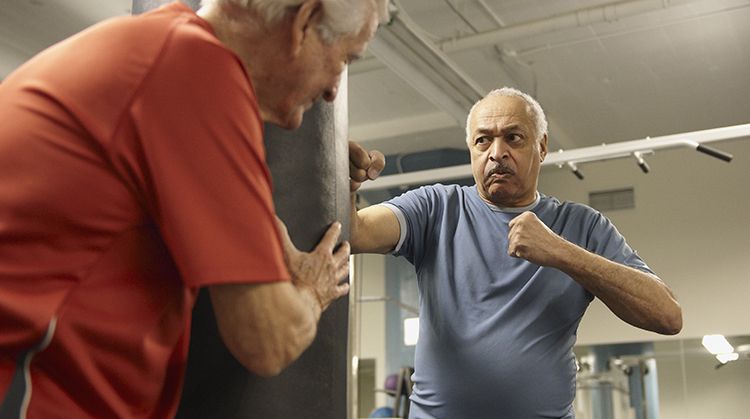6 Sports activities for those who have Parkinson Condition
The consequences of Parkinson illness include difficulty with motion and considering.
Although signs and symptoms and their severity may differ widely, the chronic degenerative condition affects brain chemicals in charge of control of body actions, thought processes, choice making, moods, and entire body consciousness and positioning.
However, this will not mean that people who have PD can’t take part in sports activities they like; actually, the opposite holds true!
Research implies that a consistent workout program, including fun athletics, can improve all those body features, plus walking balance, power, flexibility, and physical fitness in people who have PD.
A actual therapist can help individuals with PD take part in these sports activities safely by conducting a bodily evaluation and creating a personalized treatment program that includes the individuals preferred sports activity at the proper level and strength.
These sports activities and activities have already been shown by analysis to relieve outward indications of PD consist of:
1. Boxing
Top of the entire body motions of boxing (such as for example punching, jabbing, safeguarding the facial skin, aiming the fists) help restore strength, endurance, entire body positioning and recognition, and hand-attention coordination. The low body actions (such as for example lunging, weight shifting in one foot to foot another) assist in improving leg strength, stamina, and balance.
2. Cycling
The repetitive movement of pedaling a bicycle provides been shown to diminish tremors, improve walking capability and arm and leg handle, increase endurance, power, and seated balance, and enhance mood.
3. Tai chi
The slow and managed flowing motion of tai chi offers been found to greatly help with coordination, entire body positioning and consciousness, and position balance.
4. Dance
The constant changing motion patterns in dance assist in improving coordination, flexibility, entire body positioning and recognition, balance while shifting, and mood. Simply hearing songs helps some people to go better, as music appears to stimulate brain indicators to muscles in different ways. Many styles of dancing have been been shown to be efficient, which includes ballroom, Latin, waltz, modern dancing, two-stepping, and range dancing.
5. Karate
Trained in “katas” (established sequence of karate movements) and fighting strategies increases balance, mood, and considering ability.
6. Weight training exercise
Weight lifting (or doing other forms of “opposition” training) enhances strength, stamina, and balance while relocating. Weight lifting furthermore reduces fatigue.
Taking part in these activities for 12 weeks provides been shown to possess long-lasting beneficial effects. Use your actual physical therapist to pick the most likely sport for you personally.
Actual physical therapists are movement professionals. They improve standard of living through hands-on treatment, patient schooling, and prescribed movement. It is possible to contact a actual therapist straight for an evaluation. To locate a bodily therapist in your town, visit Look for a PT.
Dahmen-Zimmer K, Jansen P. Karate and dancing training to boost balance and stabilize mood in patients with Parkinson’s illness: a feasibility study. Top Med (Lausanne). 2017;4:237. Free Content.
Subramanian I. Complementary and alternative medication and workout in nonmotor outward indications of Parkinson’s condition. Int Rev Neurobiol. 2017;134:1163–1188. Article Overview in PubMed.
Hulbert S, Ashburn A, Roberts L, Verheyden G. Dancing for Parkinson’s: the consequences on body co-ordination during switching around. Complement Ther Med. 2017;32:91–97. Write-up Overview in PubMed.
Storzer L, Butz M, Hirschmann J, et al. Bicycling suppresses abnormal beta synchrony in the Parkinsonian basal ganglia. Ann Neurol. 2017;82(4):592–601. Post Overview in PubMed.
Kwok JY, Choi KC, Chan HY. Ramifications of mind-body workouts on the physiological and psychosocial well-being of people with Parkinson’s illness: a systematic evaluation and meta-evaluation. Complement Ther Med. 2016;29:121–131. Article Overview in PubMed.
Ventura MI, Barnes DE, Ross JM, Lanni KE, Sigvardt KA, Disbrow EA. A pilot research to evaluate multi-dimensional ramifications of dance for those who have Parkinson’s condition. Contemp Clin Trials. 2016;51:50–55. Free Content.
Arcolin I, Pisano F, Delconte C, et al. Intensive routine ergometer education improves gait rate and stamina in patients with Parkinson’s disease: an assessment with treadmill instruction. Restor Neurol Neurosci. 2015;34(1):125–138. Article Overview in PubMed.
Combs SA, Diehl MD, Chrzastowski C, et al. Community-based group workout for people with Parkinson illness: a randomized controlled trial. NeuroRehabilitation. 2013;32(1):117–124. Article Overview in PubMed.
Earhart GM. Dance simply because therapy for folks with Parkinson condition. Eur J Phys Rehabil Med. 2009;45(2):231–238. Free Article.
